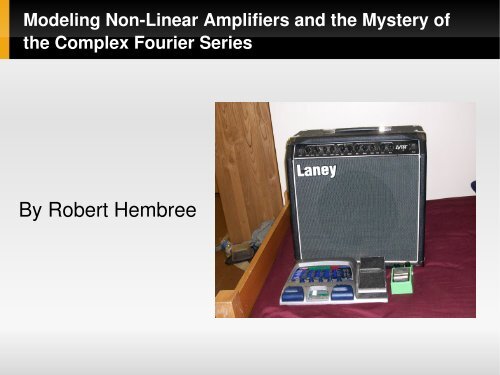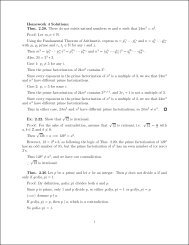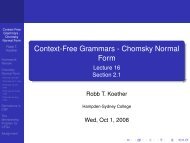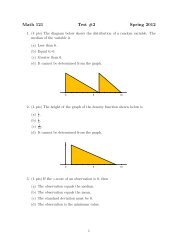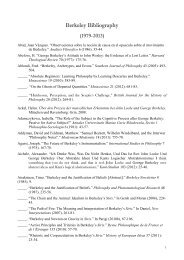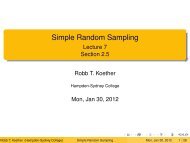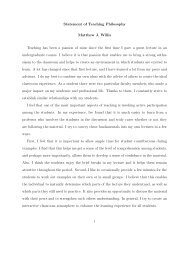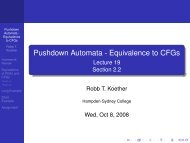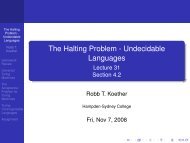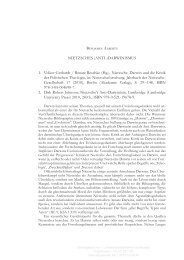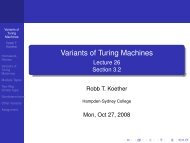Modeling Nonlinear Amplifiers
Modeling Nonlinear Amplifiers
Modeling Nonlinear Amplifiers
Create successful ePaper yourself
Turn your PDF publications into a flip-book with our unique Google optimized e-Paper software.
<strong>Modeling</strong> NonLinear <strong>Amplifiers</strong> and the Mystery of<br />
the Complex Fourier Series<br />
By Robert Hembree
Introduction<br />
<br />
<br />
<br />
Statement of Purpose and Reason behind that<br />
purpose and the Goal.<br />
What is a NonLinear Amplifier<br />
<br />
<br />
What does it do<br />
How does it work physically<br />
Mathematical Model<br />
<br />
<br />
<br />
<br />
Types of Functions<br />
Linear Gain<br />
In real life there is no clipping!!!<br />
Example sounds
Introduction Continued<br />
<br />
Mathematical Analysis<br />
<br />
<br />
<br />
<br />
<br />
Complex exponential and its Fourier Transform<br />
General Taylor Series applied to Complex<br />
Exponential<br />
Find Taylor Series of my model Functions<br />
What does that do to the signal.<br />
Plug in complex representation of Cosine<br />
<br />
<br />
<br />
Complex representation of Fourier Series!<br />
Future work<br />
References
Purpose<br />
<br />
<br />
<br />
The purpose is to model a NonLinear Amplifier,<br />
more specifically it is to model the response<br />
characteristics of a tube guitar amplifier.<br />
Recreate their warm sound.<br />
Create a cheap, effective, and eventually<br />
marketable computer based model of this<br />
phenomenon.
Reason<br />
<br />
Most solutions to this that other people have<br />
created are expensive and of low quality
Reason<br />
<br />
<br />
<br />
Most of the Cheap solutions use a simple<br />
Bicubic filter.<br />
This produces a harsh sound<br />
Many solutions will just set a hard clipping to<br />
create the distortion
What Is a NonLinear Amplifier
What it is<br />
<br />
<br />
<br />
Gain is how much a signal is amplified.<br />
In a NonLinear Amplifier the gain is variable<br />
with respect to the input volume.<br />
Instead of the gain increasing in a linear fashion<br />
it increases in a nonlinear fashion
How Does it physically work.<br />
<br />
<br />
<br />
<br />
<br />
<br />
<br />
<br />
http://en.wikipedia.org/wiki/Image:Clipping_compared_to_limiting.svg
Mathematical Model
Mathematical Models<br />
<br />
The functions need to be:<br />
<br />
<br />
Odd<br />
Bounded on top and bottom by horizontal<br />
asymptotes<br />
<br />
<br />
And for sound purposes it helps for them to be<br />
analytic (Bicubic lacks this feature)<br />
So I use:<br />
f x ,c=2/arctanc x<br />
f x ,c=tanhc x
Tanh<br />
Vout<br />
Vin
Arctan<br />
Vout<br />
Vin
Things to note<br />
<br />
<br />
<br />
<br />
<br />
As you approach zero the slope is linear. This is<br />
known as the linear gain<br />
As your voltage input gets higher the output<br />
asymptotically approaches 1 or 1<br />
We get no clipping. We never actually go<br />
outside of the physical parameters<br />
This is realistic.<br />
We can approximate clipping by setting the gain<br />
to a very high value
Linear Gain<br />
<br />
<br />
<br />
<br />
<br />
This is the amount of amplification that you get<br />
at input voltages close to zero.<br />
This can be determined by taking the derivative<br />
at zero<br />
For the arctan model we get:<br />
And for the tanh we get that gain is:<br />
linear gain = c<br />
linear gain= 2c<br />
<br />
This is a measure of how we are amplifying the<br />
signal. This value is like the percentage of<br />
signal boost.
The Model
How well does it work
More
More
Some of My results<br />
This is the Clean Signal that I started out with.
Arctan
Arctan filter Applied
Tanh applied
Mathematical Analysis
The Complex Exponential and its<br />
Fourier Transform<br />
<br />
<br />
The Complex Exponential has the form:<br />
g x=e 2 i f 0<br />
x<br />
<br />
<br />
When we take the Fourier Transform we get:<br />
F f =∫ e 2 i f 0 x e −2 f x dx= f − f 0
Taylor Series and Its Effect on the<br />
Complex Exponential<br />
<br />
So what Happens when we square the<br />
Complex Exponential:<br />
e 2 i f 0 x 2 =e 2 i 2f 0 x<br />
Meaning that the Fourier Transform becomes:<br />
F f =∫ e 2 i 2f 0 x e −2 f x dx= f −2f 0
Graphical Example
The Taylor Series<br />
<br />
In general The Taylor series is:<br />
<br />
<br />
∞<br />
g x=∑<br />
n=0<br />
g n 0 x n<br />
n !<br />
<br />
<br />
So that the effect is:<br />
F f =∫ ge 2 i f x 0<br />
e −2i f x dx=∫∑<br />
∞<br />
n=0<br />
g n 0e 2i f 0 x n<br />
n !<br />
e −2i f x dx=∑<br />
∞<br />
n=0<br />
g n 0<br />
n !<br />
f −nf 0
Taylor Expansion of my models
Tanh
Atan
A Final Curiosity<br />
<br />
Combine Cos with the Taylor series:<br />
∞<br />
gcos2 f 0<br />
x=∑<br />
n=0<br />
g n 0cos n 2 f 0<br />
x<br />
n!<br />
∞<br />
=∑<br />
n=0<br />
gn 0 e2 i f x 0<br />
e −2 i f x 0 n<br />
<br />
2 n<br />
n !<br />
<br />
Essentially what we get is the Fourier Series on<br />
expansion.


